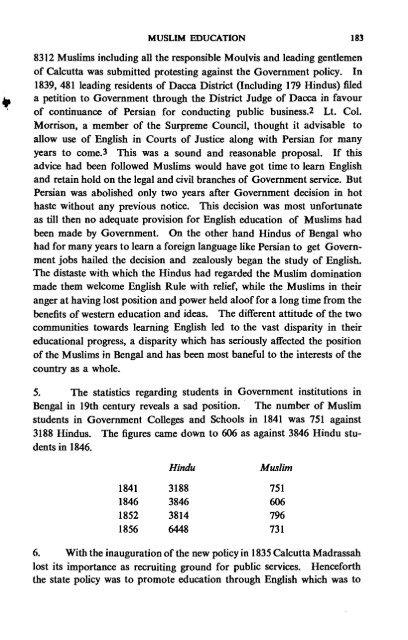MUSLIM EDUCATION IN BENGAL 1837-1937
MUSLIM EDUCATION IN BENGAL 1837-1937
MUSLIM EDUCATION IN BENGAL 1837-1937
You also want an ePaper? Increase the reach of your titles
YUMPU automatically turns print PDFs into web optimized ePapers that Google loves.
<strong>MUSLIM</strong> <strong>EDUCATION</strong> 183<br />
8312 Muslims including all the responsible Moulvis and leading gentlemen<br />
of Calcutta was submitted protesting against the Government policy. In<br />
1839, 481 leading residents of Dacca District (Including 179 Hindus) fXed<br />
a petition to Government through the District Judge of Dacca in favour<br />
of continuance of Persian for conducting public business2 Lt. Col.<br />
Morrison, a member of the Surpreme Council, thought it advisable to<br />
allow use of English in Courts of Justice along with Persian for many<br />
years to come.3 This was a sound and reasonable proposal. If this<br />
advice had been followed Muslims would have got time to learn English<br />
and retain hold on the legal and civil branches of Government service. But<br />
Persian was abolished only two years after Government decision in hot<br />
haste without any previous notice. This decision was most unfortunate<br />
as till then no adequate provision for English education of Muslims had<br />
been made by Government. On the other hand Hindus of Bengal who<br />
had for many years to learn a foreign language like Persian to get Govern-<br />
ment jobs hailed the decision and zealously began the study of English.<br />
The distaste with which the Hindus had regarded the Muslim domination<br />
made them welcome Engiish Rule with relief, while the Muslims in their<br />
anger at having lost position and power held aloof for a long time from the<br />
benefits of western education and ideas. The different attitude of the two<br />
communities towards learning English led to the vast disparity in their<br />
educational progress, a disparity which has seriously affected the position<br />
of the Muslims in Bengal and has been most baneful to the interests of the<br />
country as a whole.<br />
5. The statistics regarding students in Government institutions in<br />
Bengal in 19th century reveals a sad position. The number of Muslim<br />
students in Government Colleges and Schools in 1841 was 751 against<br />
3188 Hindus. The figures came down to 606 as against 3846 Hindu stu-<br />
dents in 1846.<br />
Hindu Muslim<br />
6. With the inauguration of the new policy in 1835 Calcutta Madrassah<br />
lost its importance as recruiting ground for public services. Henceforth<br />
the state policy was to promote education through English which was to
















